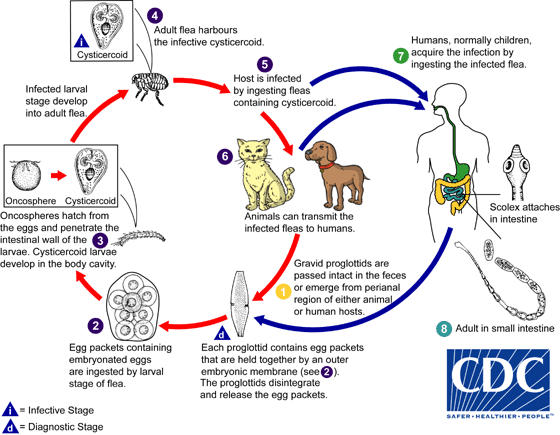Images in Clinical Medicine: Dipylidium caninum Infection¶
Summary¶
- 2yo F
- c/c
- presented to ped infxn clinic
- PEx
- visible worm in stool
- mild perianal pruritus
- Ex
- test fo ova & parasites
- (–)
- test fo ova & parasites
- Life Hx
- several pet cats
- passing similar worms
- Tx'd empirically by veterinarian
- Ex
- proglottid
- MS
- egg packet(++)
- Dx
- tape warm Dipylidium caninum
- Tx
Further¶
Dipylidium caninum (CDC)
Terminology¶
- pruritus: 掻痒
pro͞oˈrītəs - veterinarian: 獣医
- proglottid: 片節 (サナダムシなどの多節条虫の分節)
- saline: 生理食塩水
- Dipylidium caninum: 瓜実条虫, aka double-pored dog tapeworm
- flea: ノミ
- cysticercoid: 擬嚢尾虫
- praziquantel:
Original¶
A 2-year-old girl presented to the pediatric infectious disease clinic with visible worms in the stool and mild perianal pruritus. Tests for ova and parasites in the stool were initially negative. The patient’s mother reported that several pet cats in the household were passing similar worms and had been treated empirically by a veterinarian. The patient’s mother brought a freshly passed proglottid in a sterile container filled with saline for further assessment. Microscopic examination of the proglottid confirmed the presence of egg packets that were diagnostic of the tapeworm Dipylidium caninum on both wet mount (Panel A) and iodine staining (Panel B). D. caninum infection typically occurs in dogs and cats but may occur in humans after ingestion of an adult flea harboring an infective cysticercoid, particularly in children living in close proximity to infected dogs or cats. The patient was treated with a single dose of praziquantel. At follow-up 3 weeks later, the perianal pruritus had resolved, and there was no recurrence of proglottids in the stool.

